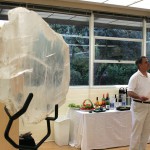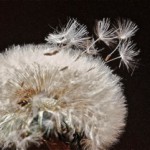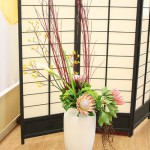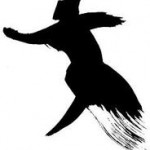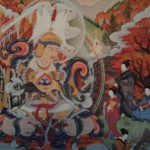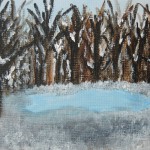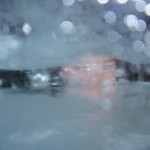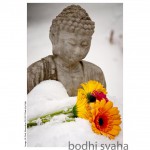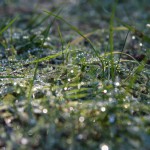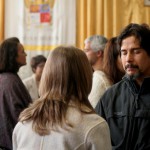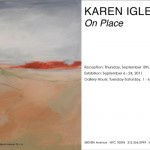Friday
Poetry by Mark Frutkin
A Word from Mark
These poems have not been published previously. They have a particular influence from my experience with meditation and the Shambhala path. I studied poetry with Allen Ginsberg when I attended Naropa Institute in Boulder, Colorado in Summer of 1976, where I also studied with other writers and heard a number of public talks by Chögyam Trungpa, Rinpoche. I have been a Buddhist meditator and a writer since the early 1970s, served as the head of the Ottawa Shambhala Centre for several years, and was appointed as the Warrior of the Centre several years ago. I have taught poetry at numerous locations: Carleton University (Ottawa), Ottawa Shambhala Centre, and Naropa Institute in Halifax. If anyone is interested in contacting me, I can be reached at [email protected]. I hope you enjoy these poems appearing in the Shambhala Times.
Without Emptiness
Without emptiness
there would exist
no spaces between fingers
or toes
leaving us with useless lumps
for hands and feet
Without emptiness
there could be no life,
for the womb
is an empty space
within each female
where life begins
Without the emptiness of space
there would be nowhere for planets
to travel or stars to move,
they would be like stones
stuck in ice,
the hunter Orion would be locked
in a cave, hibernating
with the bear known as Ursa Major
Without emptiness
nothing could happen
because there would be no space
for the poem to arise
for the lungs to breathe.
Without the emptiness of the blank page
the poem could never be written down,
without the silence in the air
the poem could never be heard.
Without emptiness
There would be no life.
Mixing Mind with Space
In meditation we say
we mix our mind with space
Blue sky
Black hole
Deep valley
Hollow mountain
Thoughtless afternoon
Dreamless sleep
Emptied drawer
Empty pocket
Car out of gas
by the side of the road
Dead horse
beside the trail
The non-number zero
A million, billion, trillion zeros
Inner ear
Outer space
Mute man
Blind woman
One minus one
One trillion minus one trillion
Blank page
Invisible ink
Leap freely
from the towering period
at the end of the poem.
Aphorism
The only way to feel
completely grounded
is to fully accept
groundlessness.
Gap
When the breath
goes out and dissolves
there’s a gap
before the next breath
is drawn in –
that gap is called
the bardo of the breath.
White Butterfly
Frantic, chaotic
the flight of the white butterfly
unstuck, unlike the leaf
stuck to its branch, its tree,
unlike the cloud pushed
in a particular direction
by prevailing winds,
unlike the stone
which moves not at all
but simply is worn away
while sinking into earth –
the white butterfly is driven,
unable to make any decision,
a bit of living trash
flicking this way and that
so like our all too
human minds.
Deep Simplicity
In Deep Simplicity
simply breathe.
Breathing in
is the world breathing out,
breathing out is the world
breathing in.
It’s that simple.
The Space that Allows
Sky is simply the space that allows
the arising and passing
of sun, moon, stars,
clouds, all celestial phenomena,
comets, lightning
and the flight of crows,
starlings and eagles,
sky is the space that allows
Eternity is the space that allows
all times: seconds, minutes, hours,
days, weeks, months,
years, lifetimes, centuries
and millennia,
eternity is the space
that allows time
Silence is the space that allows
sound: words in conversation,
songs, trill of warbler,
caw of crow,
crash, lightning, shouts,
wash of sea, trickle of creek,
silence is the space
that allows sound
The human body is the space that allows:
the empty stomach makes room
for the food to sustain life,
the empty mind
allows clarity, imagination
and the arising of new ideas,
the womb is the space that allows
the fertilized egg to grow
into new life
And finally, love is the space that allows
all emotion,
the wide-open heart that accepts
anger, joy, depression,
reconciliation, relief,
elation, happiness,
sadness, patience and empathy,
love is the space
that allows all emotion.
***
Mark Frutkin lives in Ottawa and has published 19 books, including fiction, non-fiction, and four collections of poetry, in Canada, the US, Britain, and in seven foreign translations.
His 2006 novel, Fabrizio’s Return (Knopf), won the Trillium Award and the Sunburst Award, and was a finalist for the Commonwealth Book Prize (Canada/Caribbean). His novel, Atmospheres Apollinaire (Porcupine’s Quill) was a finalist for the GG award for fiction. And finally, two of his collections of poetry have been finalists for the Ottawa Book Award. Further information on his books can be found on his website at www.markfrutkin.com
Mark came to Canada (his mother’s birthplace) as a draft resister in 1970 during the Vietnam War and lived for nine years in western Quebec in a log cabin with no electricity and no running water. Having grown up in Cleveland, Ohio and attended Loyola University in Chicago, his unusual experiences in the Canadian bush sparked his interest in poetry and it was in the cabin where he first started writing. He hopes you enjoy his work.
Entries filed under Arts and Poetry
Observing Shambhala Art Day – HIGHLIGHT
article by Amanda Tasse photos are from the Los Angeles sangha Today is Shambhala Art Day, which has been designated by Sakyong Mipham Rinpoche to occur on the spring equinox. It is a day when the entire Shambhala community and friends are invited to celebrate art forms and ... continuePosted March 20, 2012 by
A Good Eye – HIGHLIGHT
Celebrating Shambhala and the Arts by Charles Blackhall Aimless wandering is a favorite past-time for me, often with my camera slung over my shoulder. Suddenly my attention is caught by color, texture, form, light, or another striking flash. In the moment, this stops the mind and yet it’s ... continuePosted March 17, 2012 by
Rigdens at an Exhibition | Shambhala Times Community News Magazine
Rigdens at an Exhibition | Shambhala Times Community News Magazine. From: Pioneer Valley Shambhala News continuePosted March 13, 2012 by
A Brief History of Shambhala Art – HIGHLIGHT
by Steven Saitzyk, International Director of Shambhala Art How does one begin to tell a story that no one person can tell? Even finding a starting point for this tale is a challenge. I could start when I first met the Druk Sakyong, Chogyam Trungpa Rinpoche in ... continuePosted March 11, 2012 by
Shambhala and the Arts – HIGHLIGHT
This March, Shambhala Times will be celebrating Shambhala and the Arts in honor of Shambhala Art Day, which is coming up on March 20th. In the coming month, we will be focusing on the various forms of art, artistic expression, and Shambhala Art teachings. If you ... continuePosted March 5, 2012 by
Rigden on a Hilltop – HIGHLIGHT
By Jennifer Holder This short story is a tribute to the Rigden, who in Shambhala is the basic enlightened nature of all human beings and the “Possessor of Family Awareness.” Standing on a hillside, the Rigden surveys the ground. Taking in the view, assessing the arrangement of the ... continuePosted March 4, 2012 by Jennifer Holder
Water Dragon – HIGHLIGHT
This poem by Shastri Dan Hessey was spontaneously composed about the water dragon during a Werma Feast in Boulder this past weekend. Water Dragon Under the stars in the ink-black sky Ethereal breath Gathers in cumulus magnificence. Dragon’s thunder-heart beats. Pitching down the mountain’s green slope, A hidden waterfall mists and sprays where Rainbows ... continuePosted February 29, 2012 by
Beyond Time, and the White Washed Brains – HIGHLIGHT
These two short offerings were written for Acharya Noel McLellan’s grade 11 English class at the Shambhala School. The first piece, by Kelsey Borden, is a paragraph response to the poem of the week, which in this case was Season’s Greetings, by Chogyam Trungpa. The poem ... continuePosted February 16, 2012 by
Song for Shambhala Level Three
The weekend of January 13 to 15 was the occasion of a delightful Shambhala Training Level Three in Fredericton. The twelve participants were taught and inspired by Director Craig Schneider and Assistant Director David Seabrook – in his first Level as an AD – while ... continuePosted January 17, 2012 by frances_giberson
The Ability of Crazy – HIGHLIGHT
poem offered by Wendy Elizabeth Langmuir Baks, long-time member of the Shambhala community, living in Toronto Crazy is simply an ability to walk amongst the moonbeams with arms and wings wide open my love continuePosted December 25, 2011 by
laughter and tears – HIGHLIGHT
poem offered by Jeff A. Fink we were once shiny, undented had baby after baby with limitless perfect futures. we had answers, speed and never enough time, we were accelerating. last night fall came to this mountain the face of the grey man peering through the glass, this morning we sit beneath a weakening sun the ... continuePosted December 10, 2011 by
Dathun Ducks
from an anonymous contributor In 2008, I had the great fortune to be able to participate in the winter dathun at Shambhala Mountain Center. It was a great experience for me and I’m very grateful to Chogyam Trungpa Rinpoche and his lineage for having created Shambhala, the ... continuePosted October 25, 2011 by
Being alone being together – HIGHLIGHT
by Joan Whitaker Sitting alone under a tree Wandering off Re-collecting Coming back to Sitting alone under a tree in the mountain Breathing with the brilliant sun warming and the wind blowing and beating and the vast blue sky inspiring and uplifting. Sitting alone Under a tree Wandering off Re-collecting Coming back to Sitting alone Under the trees In the mountains Breathing With you With each of you Thinking Feeling Seeing Hearing Touching Moving Sighing Laughing Crying Clearing Being ... continuePosted October 22, 2011 by
Learning, Appreciation and Commitment… – HIGHLIGHT
Voices from the Latin American Kalapa Governance Gathering in Chile More than 70 members and leaders of the Shambhala community in Latin America gathered in Santiago Chile this past weekend for the ninth Kalapa Governance Gathering. At the conclusion, they formed a large circle and spoke spontaneously ... continuePosted September 24, 2011 by
On Place: New York City Art Show
Long time Shambhala sangha member Karen Iglehart is having an art show in New York City from September 6th – 24th. Her work has been on display at Karme Choling in the teacher’s suite, foyer, and Director’s office since May. Her paintings will remain hanging there ... continuePosted August 30, 2011 by
![]() RSS feed for the Arts and Poetry category
RSS feed for the Arts and Poetry category
View all posts from authors in Arts and Poetry: jillian_johnson



